The Catholic Church in the United States
IV. Christianity without the Cross
(1921-2000)
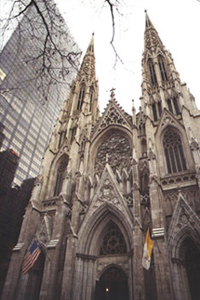
in New York
THE beginning of the 1920s indubitably marked a new stage of the Church’s history in the USA. It was not a rupture with the preceding period but, on the contrary, a consolidation of Cardinal Gibbons’ work. From 1921 to 1960, Catholic Americans would win a title of incontestable American citizenship, but at what cost?
Yet, at the beginning of this period, anti-papist prejudice remained virulent, despite the exemplary patriotism of Catholics during the war. The Ku Klux Klan that revived in 1915, gathered four million five hundred thousand members under the slogan: « American, White, Protestant »; it gained the passage of new legislation on immigration, legislation whose real aim was to check Catholic immigration.
A part of the American population still remained fiercely opposed to Catholics’ standing as candidates for high national office, even within the Democratic Party, whose Catholics were, however, faithful voters. Thus it was that in 1924, Alfred Smith, the very popular Catholic governor of New York, failed to have himself designated as Democratic candidate for the presidential election. He succeeded in 1928, but he was defeated by the Republican Hoover, whose electoral campaign especially found fault with his Catholicism. As a result, in 1932 the Democratic Party once again preferred over Smith a Protestant, Franklin Roosevelt, who was elected.
The latter would, however, wait until 1936 before he dared to receive officially a representative of the Pope, Cardinal Pacelli, the future Pius XII, to be specific. Even then he only invited him to his private residence and not to the White House! The outbreak of the war in 1939 was necessary to give him the opportunity to appoint – without causing too great a stir – a personal representative to the Vatican, who held the rank of an ambassador.
CAPITALISTS BUT CONCERNED WITH SOCIAL ISSUES
Actually, it was through their commitment in the social realm during the crisis of 1929 that Catholics would be incontestably established, making the opposition of the fanatical Protestants inoperative.

As early as 1920, Mgr Muldoon and Fr. Ryan, who were supported by the episcopate, had worried about the anarchical development of American capitalism and feared a crisis. They took the initiative in creating an « itinerant school of social thought » that initiated hundreds of thousands people in the social doctrine of the Church, applied to American economy and to its working conditions.
Unfortunately, Catholic employers showed themselves very hesitant. Most of them had recently launched into business and knew only one model, liberal Protestant capitalism which was working very well for them.
On the other hand, the clergy took an active interest in these matters and several dioceses created social support services. Many men and women religious also undertook a formation that enabled them later on to teach applied sociology.
Therefore, when the crisis of 1929 broke out, the Catholic Church was not caught off guard. She was already partially organised to help the unemployed. There would be 4 million in 1930, 8 million the following year and 12 million in 1932.
Catholics were also the only ones at the time, to propose theoretical solutions to remedy the crisis and prevent it from recurring. They would know how to make themselves heard.
The dean of the new school of social sciences at the Catholic University of America, Mgr Francis Haas, was one of the first to insist on the necessity of developing free trade unions that would prepare setting up a modern corporative system.
The Church’s social doctrine was broadcast on the radio thanks to the extremely popular programme of Fr. Charles Coughlin, “the radio priest”. He used his influence to have Roosevelt elected, but then, disappointed by the New Deal, he formed his own party, drawing his inspiration from the example of Mussolini. Disowned by the hierarchy, Fr. Coughlin retired from public life.
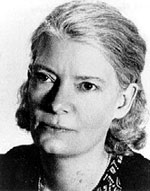
Dorothy Day appears as a totally different figure of American Catholicism. She was born in Brooklyn in 1897 into a middle-class family but, independent by nature and feminist, she became a journalist and frequented socialist and anarchist circles. She converted at the beginning of the 30s and met Pierre Maurin, a French philosopher, pacifist and disciple of the Christian Democrat Marc Sangnier, who advocated the return to a poorer and more natural life. Together they founded “The Catholic Worker” in 1932, a very inexpensive publication that extolled social justice and Christian philosophy of labour. At the same time, Dorothy Day opened the first “House of Hospitality” that not only offered the poor free meals but also social aid services. In a few years, thirty or so of these houses were founded in the USA. She also took an active part in many social movements in order to counter the Communists.
In 1932, Michael O’Shaughnessy, a Catholic who was an oil company director, founded “the League for Social Justice” that was intended to study and implement the pontifical doctrine. He advocated in particular the formation of company associations in order to ensure equitable distribution of work, as well as setting up pension funds, health insurance and welfare assistance. The league, which was recognised by sixty-five bishops, nevertheless had few members, but its influence was significant, in particular, during the New Deal. It defended before the courts the social measures of this policy, which were contested by a segment of employers. It also inspired the law on the industrial organisation committee, which enabled the rapid expansion of trade unionism.
If Catholics founded and made consumers’ cooperatives thrive, on the other hand, all their attempts at professional unions failed. It is important to notice this. Americans are resolutely capitalists, and Catholics were in the end only able to humanise the system without succeeding in changing it. There is, moreover, the whole ambiguity of the social doctrine of the Church, actually that of Leo XIII, who was influenced by Cardinal Gibbons: this supposedly Catholic doctrine adapts in fact to an economical system inherited from the Protestant Reform!
Catholics, who were already unconditional supporters of American institutions, thus became in the thirties the useful collaborators of American capitalism in the social sphere; this earned them a little bit more respect and esteem.
A POWERFUL INSTITUTION
It is well known: every Protestant tinged with Calvinism considers financial success as a sign of God’s blessing. Judging from this scale of values, American Protestants should honestly conclude that God blesses the Catholic Church! In fact, from 1920 to 1940, while the clergy increased in number, the Church also became a financial power, which was established on important real estate and on the generosity of her faithful. She displayed all the outward signs of social success.

It was the Eucharistic Congress of 1926 in Chicago that revealed Catholic power to the eyes of all Americans. Cardinal Mundelein had spent millions of dollars to ensure its success! For four days, crowds unashamedly multiplied public acts of devotion in honour of the Eucharist, although Americans did not at all make a habit of it. There were 10 cardinals, 257 bishops and archbishops, 2000 priests! From this date until the war, the number of conversions reached around 35,000 per year.
At that time the Church had around 20,000 well-organised parishes and a clergy that the faithful respected, although it was not very intellectual and lived without austerities. At the end of World War I, she numbered 18,700 priests, and 22,500 ten years later. In 1939, there were 17,000 seminarians! 7,600 religious men in 1928 and 10,900 in 1939. In 1939, 40,000 religious women were, however, divided among 100 different congregations, only 4 of which had more than 350 members. The number of students who attended Catholic universities was constantly increasing as well.
Nevertheless, future bishops were chosen more for their administrative qualities than for their apostolic zeal or their theological science. This was so because at that time, the financial capacities of the Church and the opulence of her institutions scandalised no one.
Religious practice was generally intense. In 1927, in Catholic universities, the number of students who received Communion several times per week was reckoned at 28 %. It was in the USA that, from 1925 on, the bilingual missal for the faithful was brought to general use. Parishes often offered biblical study courses. Closed retreats met with a great success as well as novenas accompanied with preaching. Sessions of catechism for adults were regularly organised and well attended. Brochures that developed doctrinal points were abundantly distributed. In 1927, a young priest, the future Mgr Fulton Sheen, began to deal with questions of dogma and morality on the radio. In 1939, there were 600 Catholic newspapers or periodicals.
Yet, this effort seemed to have only little influence on the faithful’s everyday lifestyle, which the American spirit still dominated.
Missionary activity only represented a small part of the American Church’s concerns. Likewise, the small interest that the Church took in the Black population, which was then gathering in the ghettos of the large cities, is surprising. Despite the efforts of some priests, in particular the Jesuit, John Lafarge and his review America, in 1927 there were only 250,000 coloured Catholics. It was not until 1936 that a Catholic university agreed to open its doors to a Black student. The last notable racist event in the USA would occur in Chicago in 1966 and among Catholics! In 1977, there were only 190 coloured priests and 900 coloured nuns in the USA! It was only in 1987 that the Conference of Bishops took measures aiming at definitely remedying segregation in the Church; about ten Black priests were then raised to the episcopate.
RELIGIOUS FREEDOM AND APOSTASY
This succession of statistics is, however, powerless to make us grasp to what extent the American Catholic Church is very different from the Church everywhere else in the world; and it is this difference that became more pronounced in the first half of the 20th century.
We should know that at that time, despite the presence of more than 250 religious denominations, for the most part Protestant, the United States is in fact an areligious society. Since the pastors and preachers of these sects are elected by the faithful, they are practically unable to contradict the latter, unless they rescind their function. By that simple fact, “religion” has been emptied of all objective and permanent content in order to become the mere framework of a community’s social life or of a set of practices and opinions that always reflects the state of mind of its members. The religious life of Americans who frequent one or another of these co-called Christian denominations is therefore, first and foremost, pragmatic and bereft of any spiritual elevation. Thus it was that American Protestant thinking emptied the notion of sacrifice of all its meaning. Religion was at the service of the community, at the service of the faithful’s good and happiness here below.
The Catholic Church could have been an exception to the rule. Superior in number and endowed with a better trained clergy, she has a doctrine and a liturgical life that gives her a different “spirit” from that of other denominations. Moreover, this was the reproach that Catholics continually endured: the Catholic Church and the American spirit are incompatible…
But as the Church wanted to avoid a clash at all costs, she was led to stress what brought her closer to others and to relativise her differences. Catholics wanted to be attached to American political institutions more than others, they were more patriotic than anyone else, and they also wanted to be more attached to religious freedom than anyone else.
The result of this frenzy to remain on good terms with other religious denominations was to weaken the Catholic faith. Religious freedom, respect for error in other religions, accepting neutral public education, exalting democracy with its values of individual liberty and social success, have created a feeling of religious indifferentism, which, combined with the search for material comfort, has been fatal to the faith of a great number of Catholics. This is the underlying cause of the numbers of apostates that the Church has always had to deplore in the United States. Moreover, the average American is convinced that to leave the Church and to create one’s own religion is not tantamount to becoming less religious, since all religions have to be respected.
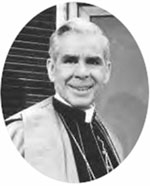
Religious freedom, which was accepted by the Church, has thus consolidated the 250 religious denominations on an equal footing with her! This took place under the watchful eye of the political power, which is dominated by Freemasonry with its neutrality, in other words, its opposition to the Kingship of Christ, overhanging the whole.
As for the faithful and the clergy, they were also subject to the attractive force of the American spirit. The prevailing materialism corrupted the Gospel ideal among them, and if the Church had taken such an interest in social justice, it was also with the concern to prove that she was not the enemy of human happiness here below. Even those who were the most desirous of converting their compatriots, such as the popular Mgr Fulton Sheen, developed an apologetic that was mainly focused on the points of agreement between Catholicism and the American ideal.
Thus it was that even in the Catholic Church, the importance of the Cross of Christ diminished, while family or convivial virtues, respect for others became the ideal of religion.
This weakening of religious zeal was one of the bad fruits of religious freedom. American Catholics admittedly think that the salvation of souls was won by Christ on His Cross, but in practice, adhering to His one Church through faith does not seem necessary to them for all that. It is not surprising therefore that they are confident of their salvation despite the laxity of their life. It is, moreover, noteworthy that this populous American Church has produced so few saints, compared with the French Canadian Church! Likewise, there would be practically no Catholic literature or art in the United States.
By agreeing to religious freedom, the American Church has deprived herself of integral Catholicism and became in the thirties a movement for the spiritual animation of Democracy.
THE CATHOLIC HOUR
It was still more obvious shortly after World War II, during which bishops had unconditionally supported the government. They refrained from all criticism of bombing civilians and the atomic bomb and approved of the alliance with Stalin’s Russia despite the condemnations of Communism.
In his book “The Catholics in the United States”, Marcel Launay entitles his chapter devoted to the post-war years: “The Catholic Hour”. The title is well chosen, since the Church was at that time certainly the most active institution of the country. In a great many spheres, Catholics had seized the first places. And yet…
If after the war two-thirds of Americans were registered in a religious denomination, less than half of them were before the war; Catholics, who formed a little more than 20 % of the population in 1940, still represented no more than 23 % after 1945. Yet, half of the immigrants during those years were Catholics, and their arrival made the American population increase by 1.7 % per year! Thus the percentage of Catholics should have increased much more… In reality, the natural growth of the population, the arrival of immigrants, and conversions hardly compensated for the number of Catholics apostatising. Even at the height of the wave of conversions (1958), this number is reckoned at 7 % of the number of baptised!
It was, however, the arrival of refugees from Eastern Europe in parishes that precipitated a change of behaviour among Catholics in American society. They were very much welcomed, rapidly assimilated, and related their torments caused by the Communists. This led their coreligionists to take a sudden interest in both national and international politics.
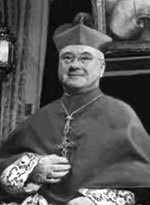
For its part, the Catholic hierarchy, however, remained the non-partisan support of the American system still for a long time to come. Cardinal Spellman, the Archbishop of New York and the most outstanding prelate of the episcopate at that time, declared: « America, to which I grant the entire capacity of devotion of my heart, is God’s herald in history. It proclaims to the world the dignity, duty, and destiny of nations under a free government », and he added: « Every true American has the vocation to go on a crusade for this spirit that is America. »
What was new was the commitment of Catholics in political action: at first exceptionally, it then became more frequent. There were in Truman’s and Eisenhower’s entourage Catholics who held the highest-ranking posts. In 1958, when the Catholic John Kennedy entered the Senate, 43 members of the Congress out of 534 were Catholics. Seven Catholics were also elected as governors. In the world of business, they also enjoyed success in greater numbers.
But it was mainly on the occasion of anticommunist campaigns that Catholics got the habit of taking an active part in actions of national scale. Senator McCarthy, the champion of anticommunism from 1950 to 1954, was a practising Catholic. Even after the warnings of the episcopate against the deviations of his combat and his withdrawal from political life, anticommunism remained firmly rooted among Catholics. One should mention the remarkable development of the Blue Army, which made the message of Fatima known.

In 1960 John Kennedy was elected president following a campaign during which, for the last time, anti-Catholic prejudice resurfaced. Despite this fact, 75 to 81 % of Jews, 61 to 68 % of Blacks, but also 38 to 46 % of Protestants voted for him as had 70 to 80 % of Catholics. This election was a turning point: with the help of the young president’s popularity, to be Catholic was, from then on, no longer an obstacle to social success.
In the following years, the episcopate supported the Vietnam War, which it declared to be just. Catholic youth would only gradually join the pacifist movement. It had Dorothy Day and the Trappist monk and writer, Thomas Merton among its highest ranking members. Intellectual life had widely developed around Catholic universities, but it was influenced by French personalist thinkers who had stayed in the United States during the war, especially Jacques Maritain, whose theories were in keeping with Cross-less American Christianity.
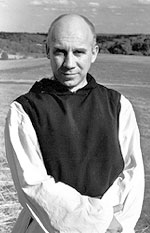
On the other hand, ecumenism was completely absent from the Catholic landscape of those years. Since everyone lived peacefully side by side, no one felt the need to unite! The first study carried out in favour of ecumenism was only published in 1957, and the first official meeting with Lutherans only took place in 1965.
So, what distinguished the Catholic American from other Americans? It is not an exaggeration to say that it was essentially his regular participation in Sunday Mass. It was a very enthusiastic and also conquering participation, since it was often the cause of conversions from Protestantism. Even Catholic immigrants who came from countries where they attended Mass only occasionally adopted a more regular practice through contact with the parish into which they had been welcomed.
On the eve of the Council, the American Church was thus a powerful and rich institution that rested on a united episcopate. She provided her faithful with a flourishing liturgical life as well as with a great many services and works of charity. This being so, it really seems that the only ambition of Catholics was to make a success of their social life like the best of their fellow citizens.
THE SECOND VATICAN COUNCIL
The convocation of the Second Vatican Council surprised the American episcopate. Apart from Cardinals Cushing of Boston and O’Hara of Philadelphia, Archbishops Schulte of Indianapolis, Rummel of New Orleans and Meyer of Chicago, who were open to novelties, all the bishops were conservative, especially the most prestigious of them, Cardinal Spellman of New York. 149 of the 200 bishops, answered the questionnaires that were used to prepare the conciliar debates; 58 asked for a wider practice of the vernacular language in the liturgy, 52 wished a reform of the seminaries aiming at adapting them more to the modern world, 16 called for a permanent diaconate for married men. But their general concern was the erosion of the discipline among the faithful. It was notable that none of them took an interest in issues concerning the universal Church.

If the American episcopate was conspicuous by its discretion during the first session of the Council, the debate on religious freedom brought them to the forefront. The progressivist minority wanted, in fact, to use the American model as a guaranty in order to have the novelty accepted! It was, moreover, an American Jesuit, Fr. J.C. Murray, who was appointed a peritus at the second session, who was one of the mainsprings of the declaration on religious freedom. It was he who proposed to base this right on this principle: « Man’s dignity consists in the responsible exercise of his freedom. »

Conciliar debates received wide coverage in the media of all leanings in the United States. We understand why: Vatican II was the triumph within the Church of the Reform, of the American spirit, and, thus of Freemasonry’s principles. The American episcopate was their Trojan horse at the Council because it had accepted these principles in the name of religious freedom and the separation of religion and State for two centuries!
In return, bishops were expecting an increase in conversions. Their follow citizens could no longer doubt: by decreeing the opening to the world, ecumenism and a religion that contributes to the blossoming of Man, and above all, by adopting the principle of religious freedom, Vatican II solemnly attested that there was no opposition between the American spirit and Catholicism. Americans could be proud of it. The conciliar American Church would now conquer America; Cardinal Gibbons’ dream would come true…
THE POST-CONCILIAR CRISIS
Such was not the case. On the face of it, it is paradoxical! Vatican II adopted the American Catholic religion… and American Catholics no longer recognise themselves in it. It is because, as we have seen, their religion was based on the liturgy and the authority of bishops. Now, the Council changed the liturgy and led to contesting the authority of bishops… the mainstays of American Catholicism were collapsing!
Many Catholics deserted the Church following the promulgation of the new rite of the Mass, which resembled the Protestant services far too much! Sunday Mass attendance dropped to 40 %, while 14 % of the baptised apostatised. During the ten years that followed the Council, 15,000 priests left their ministry, congregations of men lost half of their members, and women congregations lost almost as many, which provoked the closing of numerous schools and hospitals. At the same time, the Supreme Court intensified the secularisation of public institutions.
As for the episcopate, which had been almost entirely renewed in the ten years following the Council, it was mainly attacked on three points.
The most sensitive point was birth control. While in 1950, 80 % of Catholic women submitted to Catholic morality, they were only 9 % in 1980. Several American theologians, in particular, Fr. Curran, openly contested the stance taken by Rome.
Nuns vehemently called for a reform of religious life and participation in decision-making within the Church. More often than not they came up against the firm opposition of the episcopate, which turned down their request point-blank, but also against a large minority of their fellow nuns. From this followed the split within many congregations: the majority left in order to form non-canonical autonomous groups, while the minority remained but was forced to reduce the activities of their community.
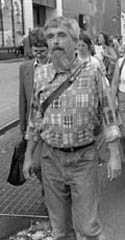
The opposition to the war in Vietnam, at last, crystallised the calling into question of the authority of bishops. While bishops were careful not to intervene on the political ground even remotely, more and more Catholics contested the legitimacy of this war and even of all war. At that time, the Berrigan brothers, Daniel, a Jesuit, and Philip, a Josephite, were the figureheads the Catholic pacifist movement. The turn of events in Vietnam proved them right. So, the episcopate rallied to it and dared to intervene in the foreign political realm in order to condemn nuclear armament. That was not done without some resistance within the Church herself, since a large number of Catholics who had remained anticommunist considered these stands as too favourable to Moscow’s policies.
The other novelty of the post-conciliar American Church was the birth of the Catholic Charismatic movement in August 1966 at Duquesne University in Pittsburgh, which was administered by the Fathers of the Holy Spirit, and then at Notre Dame University, which belonged to the Holy Cross Fathers. Directly inspired – that is the suitable word – by Protestant Pentecostalism, it rapidly developed: in ten years or so, 3000 prayer groups gathered a million faithful in the USA.
We should also mention the end of racial segregation towards Blacks and the interest that was now taken in the Spanish-speaking population – 90 % of whom are Catholics. Their number increased by 61 % while the American population grew by 11 %. Although 15 % of them passed over to Protestantism, Spanish speakers currently represent a third of American Catholics.

It must not be imagined, however, that this acceleration of the disorientation in the American Church shortly after the Council went off smoothly. Besides the faithful who joined the Lefebvrists, a conservative nucleus attached to the dignity of worship and to morality remained in the parishes. It made possible a notable recovery following Carter’s presidency, which, in the eyes of many people, was another American collapse after that of Vietnam.
In political matters, these Catholics supported the Republican Reagan; in moral matters, they adopted John Paul II’s stands. With yet unknown firmness, they intervened in the political debate in the name of Catholic morality. Cardinal O’Connor of New York even dared to give Catholics guidance on how to vote against candidates who agreed to the abortion law! For the first time, a bishop thus challenged the principle of separation. It was short-lived, but the Church had demonstrated that from then on she was a political force to be reckoned with.
As for religious practice, it has risen again to 53 %, and it is in the USA that Catholics proportionally have the most priests: 11.7 priests for 10,000 Catholics. Nevertheless, the proportion of Catholics within the American population is continually decreasing and is presently the same level as before World War II.
The moral scandals of these last years have compromised what in the eyes of some people was regarded as a renaissance. Progressivists take advantage of this to criticise the reactionary episcopate and to try to destabilise it while Freemasonry and the remnants of fanatical Protestantism do not miss this opportunity to attack the Church.
Nevertheless, for certain traditionalists who are alarmed by the Church’s general collapse in the West, the American Church may appear to be a model. A model of integral Catholicism? Certainly not, or we would have to maintain that the Gospel and the life of saints announce the American way of life! But she is certainly a model of the conciliar religion in the Church. For, our Father has demonstrated it without ever having been refuted, within the one Church founded by Jesus Christ, there are presently two religions that confront one another: the Catholic religion focused on the Cross of Christ and the conciliar religion based on religious freedom and the cult of Man. The history of the American Church persuades us that the latter, far from building a better world, is the accomplice of the destroyers of Catholic order and produces nothing but ruins.
Fortunately, Our Lady of Fatima, for whom many Americans had a great devotion, will triumph over the heart of the Holy Father and compel him to disavow religious freedom; then the Catholic Church will be born anew in the United States, too.